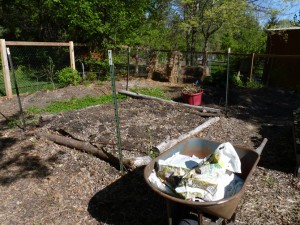Spring Waxing Bee Hiving Moon
Let the rainy season begin. Thunder in the forecast for tomorrow. That means Rigel slinking around, barking at the sky, and, with Sollie and Gertie here, amping up the possible opportunities for red in tooth and claw encounters. Temperate climates change the game every three months or so, just to see if we’re still alert.
There is an argument in the Star-Tribune today that correlates 50-100 mm of rain a year with democracy. This is a new version of an old staple, geographical determinism, now sometimes called environmental determinism. In essence geographical determinists equate a particular land form or climate with political destiny. An explanation from about.com is below.
“The main argument of environmental determinism states that an area’s physical characteristics like climate have a strong impact on the psychological outlook of its inhabitants. These varied outlooks then spread throughout a population and help define the overall behavior and culture of a society. For instance it was said that areas in the tropics were less developed than higher latitudes because the continuously warm weather there made it easier to survive and thus, people living there did not work as hard to ensure their survival…
By the 1950s, (my emphasis, note that this perspective held sway in geography until recently, and, in fact re-emerges now and then. See today’s star-trib.) environmental determinism was almost entirely replaced in geography by environmental possibilism, effectively ending its prominence as the central theory in the discipline. Regardless of its decline however, environmental determinism was an important component of geographic history as it initially represented an attempt by early geographers to explain the patterns they saw developing across the globe.”
The main problem with this line of thought is that it confuses correlation with causation. In other words it is deductive rather than inductive. In its earliest and grossest form it posited, for example, that equatorial regions produced lazy, shiftless people because food was so readily available. A later version of the same argument claims to correlate 70% of a nations or regions economic production by its distance from the equator. The reasoning though is backward.
Take the article claiming the causal link between rainfall and democracy in the paper this morning. It looks at democracies, notes that most fall in temperate regions and asks the question, why is that? In answering this question they come to a conclusion that moderate rainfall has a goldilocks effect producing an ideal agricultural environment with an environment conducive to food storage (cold winters). This leads to individual property and strength of individuals who can then join together in democratic government.
Well. Here’s the way it would have to go if the theory were to actually work. First, you would have to take a geographic or climactic feature, let’s say rainfall, then look at what rainfall produces and then predict what cultural and political configurations were likely. At that point you could take your theory out into the wide world and see if it matched up. If it did, then you might, note might, have a law. The might, even in this method, is that even with prediction, correlation is not always causation. That’s why scientific theories have to be tested and verified by others, others who don’t have your assumptions.
Both culture and political configurations are far too many variables removed from climate and geography to demonstrate causation rather than correlation. That is, the human mind and the creativity of the group, can overcome, in fact, has a long track record of overcoming geographic and climactic variations. Overcoming, not being overcome by. We may argue whether that’s good or not, but it is a fact.
And, oh, by the way, this article doesn’t account for China, the world’s largest autocratic state with quite a bit of temperate climate.

 based businesses with marketing assistance. A woman gave a presentation on cooking with honey. How to make truffles. Uh-oh. They were really good. Not a healthful food, but my were they tasty.
based businesses with marketing assistance. A woman gave a presentation on cooking with honey. How to make truffles. Uh-oh. They were really good. Not a healthful food, but my were they tasty. The leeks will go in the next week, already begun inside, and the potatoes will go out a bit after they arrive, probably late week after next. The garlic, strawberries, rhubarb, asparagus, raspberries and a few stray onions have a jump on the season, as do a couple of perennial herbs. When they come, I’ll drop in the carrots and beans and peas. Feels good to have the outdoor garden started.
The leeks will go in the next week, already begun inside, and the potatoes will go out a bit after they arrive, probably late week after next. The garlic, strawberries, rhubarb, asparagus, raspberries and a few stray onions have a jump on the season, as do a couple of perennial herbs. When they come, I’ll drop in the carrots and beans and peas. Feels good to have the outdoor garden started. anyhow.
anyhow.